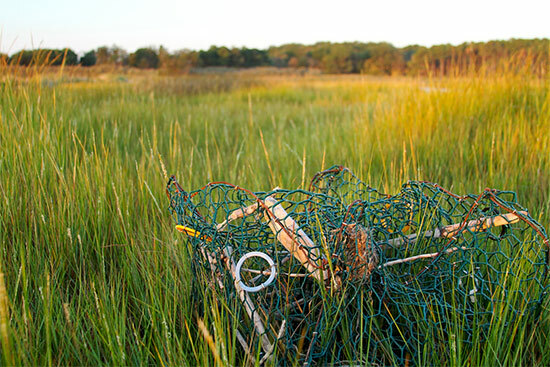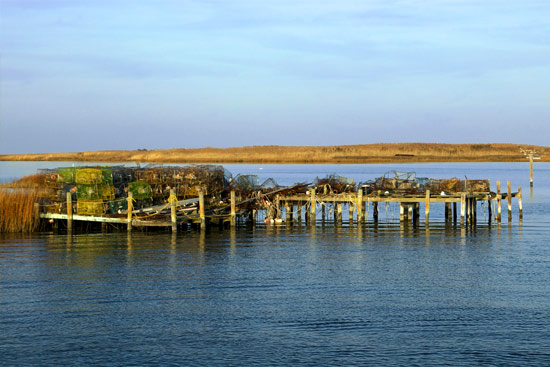Discarded, derelict fishing traps harm blue crabs, watermen in Chesapeake Bay
Biodegradable escape panels could solve the region's ghost fishing problem.
Sunken fishing traps are having a big impact on wildlife in coastal waters around the United States, including blue crabs and the watermen who depend on them in Maryland, Virginia and North Carolina.

According to a report from the National Oceanic and Atmospheric Administration (NOAA), the problem of derelict fishing gear—which includes lost and discarded nets and traps—is “pervasive, persistent and largely preventable.” Whether accidentally lost or intentionally tossed overboard, derelict gear can continue to “ghost fish,” catching fish, turtles and other species and damaging seafloor habitats. In some cases, dead organisms continue to serve as bait until the traps stop catching fish.
“People may not realize that derelict traps can catch not just the target species of the fishery, but also other animals, including threatened and endangered species where populations are already very low,” said scientist Ariana Sutton-Grier in a media release.
In the Chesapeake Bay, derelict crab traps impact blue crabs, diamondback terrapins and other species. Between 35 and 40 percent of derelict traps are ghost fishing, with the highest catch rates taking place in Maryland waters. Here, about 20 blue crabs per trap per year are caught and killed, which researchers attribute to gear that is not designed to allow species to escape when traps become derelict.

The loss of fishing gear has an economic impact, too. According to the report, derelict traps in Virginia waters have caught as many as 913,000 crabs in a year, with an estimated worth of $304,000, or one percent of the Commonwealth’s annual commercial blue crab landings. In addition to the impact on commercial fisheries, there is a irect cost to watermen to replace lost traps, which range from $60 to $600.
Traps with biodegradable escape panels—which are inexpensive and easy to install—have been successfully tested in the Bay, with no adverse effects on blue crab catch. These, along with boat lanes that keep propellers away from trap lines and improved outreach and education to watermen, could pose solutions to the region’s derelict fishing trap problem.

Comments
Have to agree with Mr Scerbo,Having commercial crabbed for a number of years the lost pots foul quickly and any dead crabs in there from last fishing deter any more catch.It might be found that quite the opposite is found in that the ghost pots provide habitat for small crabs and fish to escape predation.Biggest problem in Bay now is Cow nosed ray that eats everything in its path.
I have crabbed for a living with pots for over thirty years and I don't think ghost pots are as big a problem as you state. I come across lost traps now and then and very rarely is there any kinds of life in them. There are a couple of reasons for this and they are one, the pots foul quickly and do not catch any crabs . Two ,the traps are usually damaged allowing animals to escape and Three, the traps rust away fairly quickly after the anode is gone. It sounds to me like someone just really likes escape panels.
Thank you!
Your comment has been received. Before it can be published, the comment will be reviewed by our team to ensure it adheres with our rules of engagement.
Back to recent stories